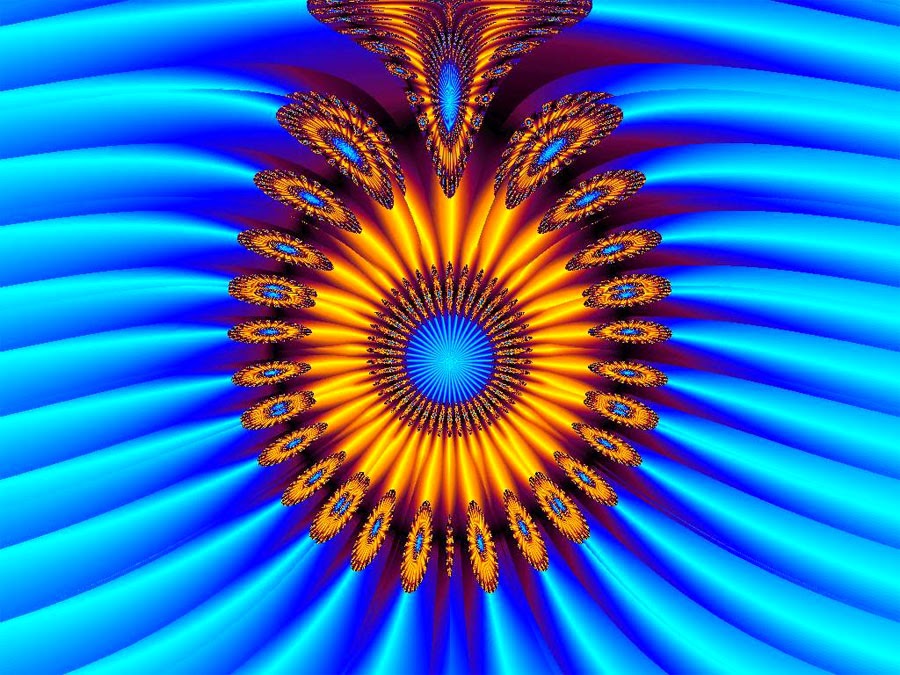 "QUANTUM SHOT" #91(rev) "QUANTUM SHOT" #91(rev)Link - article by Avi Abrams Stunning Examples of Fractal Art in History "Mandelbrot? Never heard of him!"... Before anybody knew who Mandelbrot was, artists throughout history were seeing fractals in Nature all around them, recognized fractal's precise aesthetics and introduced these patterns into their own paintings, sculptures, and designs. Fractals, as we define them now, are the infinitely recursive geometric patterns, repeated on a smaller and smaller scale, until the resulting intricate lattice-work recedes past the scope of classic geometry. They are governed by the Mandelbrot Equation and can be explored ad finitum, provided you have capable computational and visualization tools:  (image via) Human mind continuously enjoys a certain fixation on recursive fractal patterns, perhaps because our natural environment is so abundant with them. Like a dancing flame, or a streaming water, fractals attract our eye and hold our attention. However, it is only during the last 30 years that we've been able to precisely describe this exquisitely subtle set of interacting patterns. First fractal shapes were drawn by Robert W. Brooks and Peter Matelski in 1978, and then in 1980 Benoit Mandelbrot has been able to define the algorithm. Fractals may have drifted into a "cliche" category since then, and became commonplace in modern computing, but interestingly, they've enjoyed a long and rich history in art, where there was no end to their popularity with photographers and artists wanting to create visually complex forms. 1. The Medieval Celtic "Book of Kells" (597 A.D.) This magnificent cultural treasure contains a stunning variety of Irish art, designs and calligraphy at its best. Perhaps the most frequently seen design elements in this book (and in other illuminated Irish manuscripts of the period) are the closely coiled spirals connected with each other by a number of curves and terminating in the so-called "trumpet fractal pattern".  Similarly convoluted curves and spirals can be found within letters, throughout the book:  2. Fractals have a rich history in African Design: There are traces of fractal geometry to be found in typical Ethiopian ornaments:  ...in village architecture:  and even in traditional Ethiopian hair-style! -  Ron Eglash, professor of comparative studies at the Ohio State University, came up with a special tool enabling everyone to create their own fractal branching patterns found in braided hairstyles. "At first I thought it was just from unconscious social dynamics," Mr. Eglash says, "but during my fieldwork, I found that fractal designs also appear in a wide variety of intentional designs -- hairstyling, textiles, sculpture, painting, carving, metalwork -- and the recursive process of fractal algorithms are even used in African quantitative systems." - source 3. Persian & Traditional Islamic Ornaments These ancient ornaments are essentially a study in symmetry, extended and enhanced with multiple iterations:  Here are some "Persian Rug" examples, created on the computer by applying recursive fractal algorithms:  (image via) 4. Italian Renaissance & the Dutch Masters Often called "Space Filling by Iteration", this technique of creating intricate textures has been known since Renaissance and widely used to add visual interest to drawings and paintings in history of art. For example, Leonardo da Vinci in his famous Treatise of Painting described what now is called Leonardo method or "blotting method" - emphasizing the innate power of "messy forms" (like stains on old walls, amorphous clouds or muddy water) and thus helping mind to embark "on various discoveries".  Dutch painter Jan Van Goyen (1596-1656) also used "deliberate accident in art" idea to create paintings with little effort from stains of colors. Compare, for example, Van Goyen's painted clouds with a typical fractal computer-generated "cloud" rendering:  (left: Van Goyen, "Two Men on a Footbridge over a Stream", 1655, oil on panel; right: "The cloud" generated by Iterated Function System, via) This technique is based on a well-known mathematical algorithm of producing space-filling curve pre-fractals:  One well-known application of generating space-filling curves in computer graphics is "half-toning" and dithering of images:  (images via) 5. Fractals in Spiritual Art It's only fitting that representations of fractals as visualization of INFINITY most frequently appear in human art within Religious and Spiritual context: Islamic, Egyptian, Judaic, Hindu and other religious symbolic arts all contain fractal elements in one form or another:     (images via 1; 2) Article by Avi Abrams, Dark Roasted Blend. CONTINUE TO THE "AWESOME FRACTAL ART" ->
|
Thursday
Pre-Fractal Art
Posted by
Unknown





